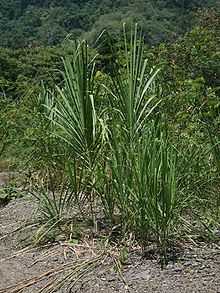Gynerium sagittatum
| Gynerium sagittatum | |
|---|---|
 | |
| Gynerium sagittatum | |
| Scientific classification | |
| Kingdom: | Plantae |
| (unranked): | Angiosperms |
| (unranked): | Monocots |
| (unranked): | Commelinids |
| Order: | Poales |
| Family: | Poaceae |
| Genus: | Gynerium |
| Species: | G. sagittatum |
| Binomial name | |
| Gynerium sagittatum (Aubl.) P. Beauv | |
Gynerium sagittatum, known locally by various common names, is a tall grass that grows up to six metres (twenty feet) high. It is a very vigorous species that grows into a considerably dense mass of vegetation. It is harvested as a semi-crop, mainly in Latin America, and has several uses. It belongs to the subfamily Arundinoideae.
Common names
Gynerium sagittatum is known as "cana-do-rio", "cana-flecha", "cana-frecha", "ubá" and "cana-brava" in Brazil, and "caña brava" in Peru and other Spanish speaking countries. It is known in English as "wild cane", while "arrow cane" is less common (sagitta is Latin for arrow).
The stems range between three and six metres in height.
Description
The stems are straight and erect, the lower part is covered with "vainas" from the fallen leaves, while in the middle part the leaves are arranged in fan shaped groups. The upper part, round and thin, stiff on the outside and soft on the inside, develops a large bloom at the top.
There are many varieties in the plant's stems. The bark zone, which is the main factor in the unusual height, functions as a water distribution system, transporting water from the underground roots to the superior part of the plant including the leaves. This vital function occurs at any season of the year.
Ecology
Being one of the first plants to colonise open areas, Gynerium sagittatum is an important pioneer species that reaches new sites via wind-distributed seeds. Once established, it spreads vegetatively, and is found usually near rivers and lakes, and even beaches.
Uses
- In Colombia its straw is used to create different accessories including the traditional sombrero vueltiao, symbol of Colombia.
- In Brazil, the lower and middle parts are used in cheap or improvised fences, and in cheap trellises for climbing plants and cultivation of tomato. The upper part, with the bloom at the top, is sometimes used in decoration. The more homogeneous section of the upper part is used to make arrows and birds cages.